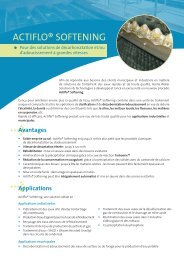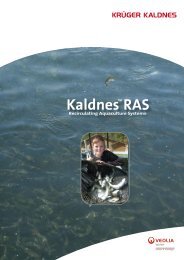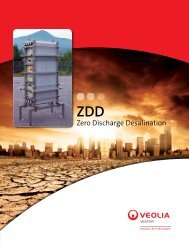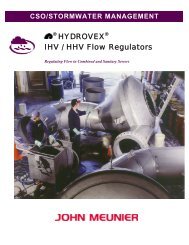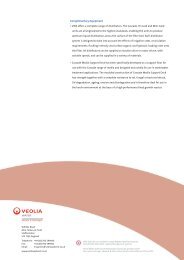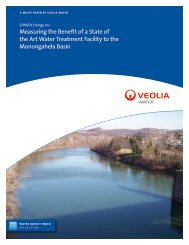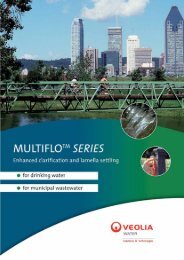Water Impact Index - Veolia Water Solutions & Technologies
Water Impact Index - Veolia Water Solutions & Technologies
Water Impact Index - Veolia Water Solutions & Technologies
Create successful ePaper yourself
Turn your PDF publications into a flip-book with our unique Google optimized e-Paper software.
The Freshwater Landscape<br />
Freshwater availability has been predicted to<br />
become a major limitation factor for growth<br />
for cities and industries in many locations<br />
around the world, and the need to understand<br />
and quantify the impact on water resources<br />
is essential to maintaining their sustainability<br />
and future prosperity because there is no<br />
substitute to water. This reality requires an<br />
understanding of the factors needed to make<br />
the most appropriate, sustainable decisions.<br />
Just as historians have connected the rise of great cities<br />
and economies with water (and in some cases, their<br />
demise), access to quality water resources is increasingly<br />
a focal point for those who plan for the future. In the<br />
developed world, urban planners, engineers, regulatory<br />
officials, environmentalists, politicians and those in<br />
charge of manufacturing operations are now focusing<br />
on whether their communities or operations will<br />
continue to have reliable access to water, necessary to<br />
ensure their continued development. Meanwhile, in<br />
the developing world, officials continue to grapple with<br />
the lack of infrastructure for basic access to water or<br />
sanitation that slows their ability to develop their societies<br />
and economies, and can even quite literally mean the<br />
difference between life and death.<br />
Are concerns about freshwater resources overblown? Are<br />
these matters for people far removed from our respective<br />
safe havens, especially for those located on lakes and<br />
riverways? Not when considering the EPA has already<br />
cited 36 states in the USA as facing water shortages and<br />
that industrial companies and investors are placing water<br />
risks on top of their list of strategic issues to address.<br />
Graphic of<br />
<strong>Water</strong> Stress <strong>Index</strong>, USA 1<br />
Stressed out?<br />
Populations continue<br />
to grow rapidly in many<br />
areas that are already<br />
experiencing water<br />
resource limitations.<br />
Populations are growing<br />
less rapidly where<br />
water resources<br />
are abundant.<br />
Consider the following:<br />
In the developing world where infrastructure is lacking,<br />
close to 1 billion people do not have proper access to<br />
healthful water, and 2.6 billion people are without<br />
sanitation systems. This triggers an incredible storm of<br />
health issues and water-borne fatalities, not to mention<br />
freshwater pollution and water resource pressure.<br />
At the same time, leakage rates in distribution networks<br />
in developed countries can exceed 50%, while the lack<br />
of proper maintenance of wastewater and stormwater<br />
collection networks leads to growing pollution.<br />
80% of all childhood deaths and illnesses in developing<br />
countries are directly or indirectly caused by lack of<br />
proper access to water or sanitation.<br />
By 2050, 75% of the world’s population will live in cities,<br />
increasing pressure on already strained water resources.<br />
Global demand for water will increase by 40% in just<br />
20 years – and is projected to double in rapidly<br />
developing countries.<br />
70% of today’s water withdrawals are used in<br />
agriculture. Population growth will lead to further<br />
significant withdrawals for agriculture, while fertilizing<br />
practices, if inappropriately managed, lead to an<br />
increasing source of water pollution affecting ground<br />
and surface water fresh resources.<br />
Climate change impacts will make the availability of<br />
freshwater resources more unpredictable. This includes<br />
droughts, floods and increased sea levels that can cause<br />
salt water intrusion in groundwater reserves.<br />
Pop, evolution (2000-2009)<br />
Average USA: +9.1% 2 Wisconsin: +5.4% 2<br />
California: +9.1% 2 Arizona: +28.6% 2<br />
Texas: +18.8% 2<br />
Based on the <strong>Water</strong> Stress <strong>Index</strong>, red represents<br />
areas that are experiencing higher levels of<br />
water stress while blue signifies areas with<br />
less or limited stress on water resources.<br />
Florida: +16.0% 2<br />
1 S. Pfister, A. Koehler, and S. Hellweg, 2009 “Assessing the environmental impact of freshwater consumption<br />
in LCA,” Environmental Science and Technology, no. 43, pp. 4098-4104<br />
2 U.S. Census Bureau, 2010<br />
A WHITE PAPER BY VEOLIA WATER 3







